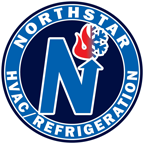Understanding Glycol and Pipe Freezing in HVAC Systems: A New England Perspective
Written by Ed Rice
In New England’s cold climate, HVAC systems must be designed to withstand harsh winters while operating efficiently. One critical component of cold-weather HVAC design is the use of glycol in hydronic systems to prevent pipe freezing. Glycol plays a pivotal role in protecting equipment, ensuring longevity, and maintaining efficiency, but it comes with specific considerations that need to be addressed during system design, installation, and maintenance.
Let’s dive into the essential aspects of glycol usage in HVAC systems, focusing on New England’s unique environmental demands.
The Role of Glycol in HVAC Systems
Glycol is added to HVAC systems to lower the freezing point of the water used as a heat transfer fluid. This prevents pipes from freezing and bursting during cold weather, which is especially important for outdoor or minimally heated spaces. Glycol solutions also protect against corrosion and scale build-up, further extending the lifespan of your system.
In the New England region, where temperatures often drop below freezing, glycol is a necessary safeguard for systems such as:
Chilled Water Cooling Systems: Protecting cooling components from frost damage during the winter months.
Hydronic Heating Systems: Preventing pipe damage in unoccupied or minimally heated buildings.
Snow Melt Systems: Ensuring outdoor systems operate safely without freezing.
Solar Thermal Systems: Avoiding damage to solar collectors and piping exposed to the elements.
Choosing the Right Glycol and Concentration
There are two primary types of glycol used in HVAC systems:
Propylene Glycol: Non-toxic and commonly used in residential and light commercial systems where safety is a priority.
Ethylene Glycol: More efficient in heat transfer but toxic, making it suitable for industrial applications where human contact is unlikely.
The concentration of glycol depends on the desired freeze protection level. For example:
33% Glycol: Provides burst protection to -30°F, ensuring that the fluid won’t expand to the point of bursting pipes.
50% Glycol: Offers freeze protection to -30°F, preventing the fluid from solidifying.
In New England’s colder regions, higher concentrations may be required to protect outdoor systems or those exposed to extreme temperatures. Consulting with a professional to determine the correct concentration is essential to avoid overuse, which can reduce efficiency and increase pumping costs.
Design and Maintenance Considerations
1. Design Adjustments for Glycol Glycol solutions have lower heat transfer efficiency and higher viscosity than water, which can impact system performance. When incorporating glycol:
Component Sizing: Pumps, pipes, and heat exchangers may need to be sized differently to accommodate the increased resistance and reduced heat transfer.
Efficiency Optimization: Ensure the system is designed with glycol’s properties in mind to maintain efficiency.
2. System Cleaning Before Glycol Addition Before adding glycol, the entire system should be thoroughly cleaned to remove debris, oil, or contaminants that could react with glycol. This step helps prevent sludge formation, pipe fouling, and reduced system performance.
3. Air Elimination Glycol solutions are prone to trapping air, leading to frothing or air pockets that can impede system function. Proper air elimination, using high-quality microbubble air eliminators, is critical during system setup and maintenance.
4. Regular Testing and Maintenance To ensure long-term reliability:
Concentration Testing: Use a refractometer to confirm glycol levels remain adequate for freeze protection.
pH Testing: Monitor the pH of the glycol solution. A drop in pH indicates the fluid is degrading and may require replacement.
System Flushing: Over time, degraded glycol should be replaced to maintain system performance and prevent corrosion.
Environmental and Safety Considerations
Disposing of glycol improperly can harm the environment and lead to regulatory issues. Work with licensed waste disposal companies to ensure compliance with local laws in New England. Additionally, always use the same glycol brand and type when refilling to avoid chemical incompatibilities.
How Northstar Refrigeration Can Help
At Northstar Refrigeration, we specialize in designing and maintaining HVAC systems that are built to withstand New England’s winters. From selecting the right glycol concentration to ensuring proper system setup and maintenance, our team is here to help you protect your investment and optimize efficiency.
Whether you’re looking to safeguard an existing system or install a new one, contact us at (508) 888-3692 to schedule a consultation. Let us help you design and maintain a system that stands up to New England’s toughest weather while delivering reliable performance year-round.
(508) 888-3692
www.northstarhvacr.com
Edward Rice
Director of Marketing,
Northstar Refrigeration, Inc.
95 Camelot Drive, Unit 1,
Plymouth, MA 02360
erice@northstarhvacr.com www.northstarhvacr.com
p: (508) 888-3692 x115
m: (508) 561-8638



